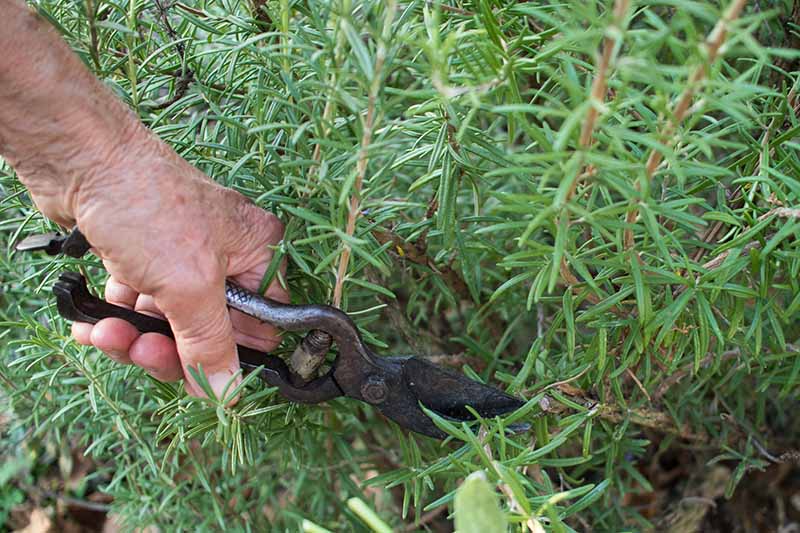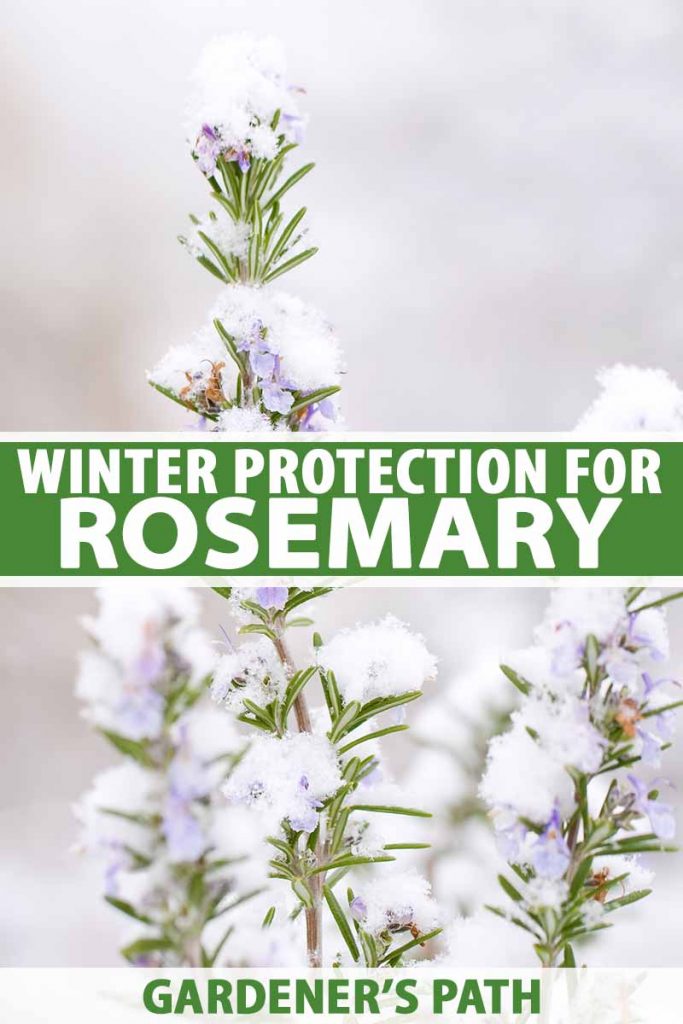If you have rosemary growing in your garden, you might be wondering if it can survive the winter outside.
Fortunately, there are measures you can take to protect your plants from the cold, and have them come back healthy and vigorous in spring.

We link to vendors to help you find relevant products. If you buy from one of our links, we may earn a commission.
Let’s see what we can do.
What You’ll Learn
Plant Hardiness Zones
A big factor in determining if your rosemary will survive the winter outdoors is your USDA Plant Hardiness Zone.

This herb is usually fine in the garden during the cooler weather in Zones 8-12. However, if you live in Zone 7 or below, it’s quite possible your plants will die if you leave them outside during the cold season.
Protecting Plants from the Elements
If you live on the edge of rosemary’s winter survival zone, in Zone 8 or 9, you’ll need to provide extra protection for your plants if you want them to overwinter outdoors.

One option is to cover them with floating row covers. This can act as a blanket and keep the air temperatures around the plants a little higher.
To do this, drape the cover over your plants, making sure there are no gaps between the ground and the material.
Secure the cover at the sides with dirt, bricks, or other weights. Gather each end to close and then weigh them down.
Another option is to prune and mulch your plants right before temperatures dip below freezing.

Using pruning shears, cut the green foliage down to about six inches tall.
Then cover the whole plant with a mulching material such as straw, leaf mold, or wood chips. This will provide protection from the drying wind and cold air.
Mulch also protects the soil from cycles of freezing and thawing, helping to keep soil temperatures stable. This allows plants to stay dormant over the winter months without sustaining damage to their roots.
You can read more about mulching to protect plants in winter here.
Potting-Up to Bring Indoors
If you live in Zone 7 or below and your plants are growing in the ground outside, you’ll need to pot them up and take them indoors away from the cold.

You’ll need to dig up your plants before the first frost has a chance to do any damage. So any time during the autumn you can move them into containers ready for the winter.
To dig up rosemary, you’ll need a shovel. In order to keep the plant healthy, it needs a large intact root ball.
Depending on the age of the plant, it can develop quite an extensive root system, and the more of this you can keep, the better.
Dig at least six inches away from the main stem. Continue moving around the plant until you have a circle that is a least a foot in diameter and a foot deep, depending on the size of your plant.
Carefully lift the plant and the root ball out of the ground, shake off some of the excess soil and place it in a large container. Add soil around the root ball and pat down gently.
Leave the plant outside for a few days to acclimate to its new container, provided there is no frost in the forecast.
A sheltered spot on a patio or balcony would be ideal. Alternatively, if you’ve got some bad weather on the way, a garage or basement would keep it safe from the elements.
You can then move it inside.

It’s best to keep the plant in a location where the temperature is above freezing, but not too hot.
A lightly heated garage or hallway is a good option, as warm indoor air can cause the plant to dry out. Rosemary likes a bit of humidity, so gentle misting of the foliage can help keep the air around it moist.
Water lightly about once a week. Make sure you don’t overwater, as rosemary hates sitting in wet soil. Growth will slow right down over the winter, but there’s a chance you can still harvest a few of the leaves.

Once the temperatures start to warm up, you can move your pot outside during the day to gradually acclimate the plant to the outdoors.
When all risk of frost has passed, you can either choose to replant it in the garden, or keep it growing in the container.
Rosemary for the Spring
If you follow the methods listed above, you’ll give your rosemary the best chance of surviving the winter.
Once spring arrives, you’ll have a fresh supply of this fragrant herb.
Let us know in the comments if you have any questions about protecting your plants.
And check out more of our rosemary care guides such as:
- The Best Cold Hardy Rosemary Varieties
- How to Care for a Rosemary Christmas Tree
- How to Propagate Rosemary Plants
© Ask the Experts, LLC. ALL RIGHTS RESERVED. See our TOS for more details. Uncredited photos: Shutterstock. With additional writing and editing by Clare Groom and Allison Sidhu.





Thanks for these tips! Will use to overwinter my container Rosemary this winter in zone 7 area.
Hello Paulette! I am in that same zone, and wish you the best of luck! I can tell you from experience that a rosemary that makes it through the winter unscathed is delicious and the scent is unbeatable in the spring garden.
I have my Rosemary plant in a container and brought it in our basement which is at about 40-50 degrees. I water it but all the needles dried up and fell off. Is it dead or do they do that over winter? Thank you
My sympathies on this dried-up rosemary plant, Cindy. There’s a good chance it has died, probably from root rot or a lack of sunlight. They need about six hours of light per day, and don’t like to sit in wet soil. You can break off one of the stems to see if it’s green inside, which could indicate it still has a chance to bounce back. Keep in mind that you can grow new plants from seeds, and late winter is the perfect time to start them indoors. If you have a friend with a healthy rosemary, you can also… Read more »
I have my rosemary in a shed that is set at 35 degrees, but we had a problem with the furnace + discovered the temp went down to 28° ..not sure how long it was at that lower temp..but noticed the plants leaves were really dry..almost brittle like, but still green…please advise on how to revive plant…thanks!
Hello Amelia Gibeauit. I hope you can salvage this rosemary plant! Start by giving it a thorough watering and then letting it drain really well. Then see if it responds to increased sunlight along with the warmer temperatures. These plants need about six hours of light per day. At the same time, I would go ahead and start some new plants either from seeds or cuttings. You can find instructions in our guide. Late winter is the perfect time to start rosemary indoors, and that way you’ll have rosemary on hand even if this particular plant doesn’t make it. Good… Read more »
I cover my rosemary bush that is in a container garden each night when the temperature is at or below freezing. Would it be ok to leave my plant uncovered during predicted snowfall? It has been thriving for over seven years now.
Hello Zosia Ulinski! So glad you’ve had a seven-year success with your rosemary.
You don’t say what USDA Hardiness Zone you live in, but if you live outside of Zones 8-9 in a colder area, I imagine you would still need to cover the rosemary if you expect snow. I say that because while snow is not always accompanied by a hard freeze, it can be, and I wouldn’t want you to risk your plant on the off-chance those temperatures are too much for it.
Thanks for reading and sharing your success.
I had a 15 foot rosemary in Nashville, TN. Planted with the roots next to a stone wall. East sun, Stone house about 10′ away. It lived until two winters in a row were odd. Unfortunately, the name had long disappeared so I don’t know what it was to plant the same again. Have tried many other varieties since the 15’er died without long term success. To keep the hardiest rosemaries outside alive for two or more years …I have wrapped burlap several layers thick around the rosemaries and lavenders…using stakes. I don’t have the burlap touch the branches or… Read more »
Thanks for reading, Mary! See our guide to the best cold-hardy rosemary varieties for more suggestions.
I am planning to winter-protect my Rosemary plants.
What mulch is best for Rosemary?
I’ve read that Blueberry plants do NOT like cedar bark mulch, which is popular around here, so am now wondering if Rosemary has any dislikes.